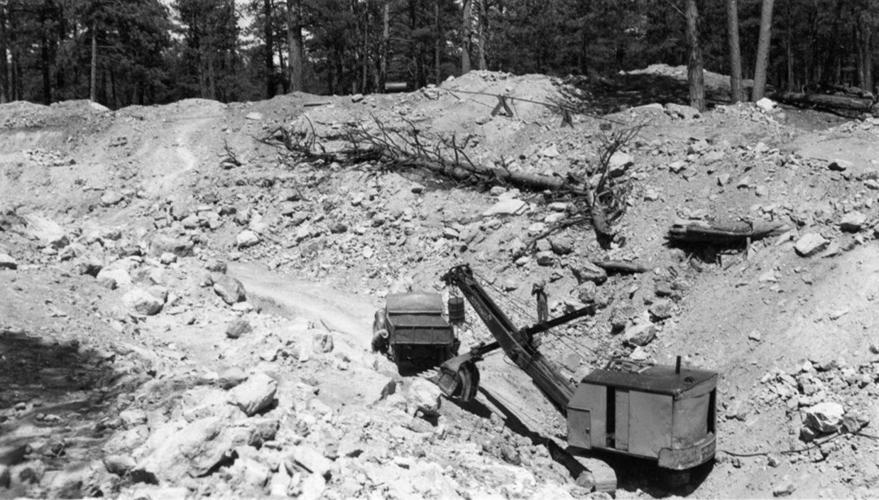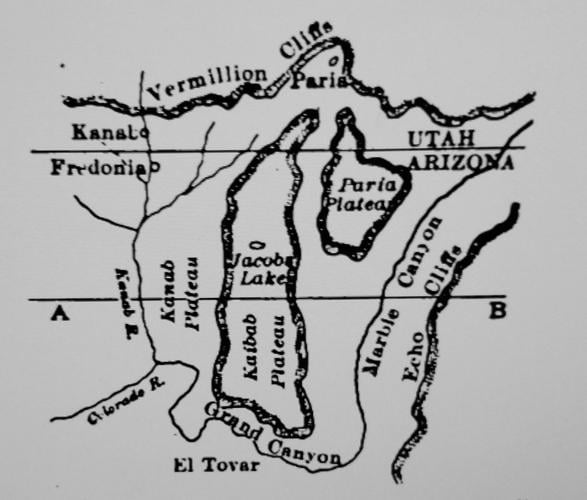The Kaibab Plateau is also known as the Buckskin Mountains because of a history of numerous mule deer hunted for their buckskin by both the Navajo and white settlers in the area.
The village of Jacob Lake, at an elevation of 7,920 feet, is a popular tourist destination located on the north side of the Grand Canyon on the Kaibab Plateau.
It is named after Mormon pioneer and explorer Jacob Hamblin. The lake is supplied by floodwater from rain and snow, and has traditionally been used as a destination to water cattle. It also served as a destination for Mormon settlers on their journey to St. George, Utah.
A sawmill existed around Jacob Lake during the 1880s.
During the 1890s, mining became prevalent after the discovery of copper oxide deposits found in limestone.
The first claim preceding the hundreds that would follow comprising the Warm Springs mining district was at Warm Springs Canyon. Officially recorded on Feb. 5, 1890, by S.W. Taylor, multiple claims established a mile west of Jacob Lake included the Copper Con., Copper Glance and Kennedy, held by local residents from Fredonia and Kanab, in addition to mining companies.
Timber for mining operations came from plentiful aspen, pine and spruce trees. Site accessibility was by wagon road from Fredonia and Lees Ferry.
Worked by the Petoskey Mining Co. in 1900, the Petoskey Mine included a small smelter built in 1901 using charcoal as fuel and water piped in from Big Springs, 7 miles to the south. However, it proved a failure because of the highly siliceous nature of the copper ore.
Headquarters for the Coconino Copper Co. that operated adjacent to the Petoskey Mine were at the mouth of Warm Springs Canyon. Known as “Coconino” or “Coconino City,” the camp became known as Ryan after a Michigan investor who purchased the mine and mill for $40,000 in 1902.
A plant was built using the Neil and Burfeind process for leaching copper ores using sulfuric acid acquired from Beaver, Utah. However, the product was not economically viable because of the instability of the copper compounds. Similar attempts on-site later involving the Esmeralda Precipitation Co. and the Buckskin Copper Co. proved discouraging.
Ryan proved ephemeral. Its post office lasted from Feb. 6 to July 18, 1902.
Resumed mining activity and stock promotion occurred during World War I.
John Mackin acquired multiple claims that would later be taken over by the St. Anthony Copper Co. in 1928. A railroad was built from the mine at Warm Spring Canyon to the former camp of Ryan to accommodate ore shipments to a 100-ton blast furnace. Attempts to build a tramway were probably hindered due to a reduced profit margin.
The Mackin Mine is credited with having produced 150,000 pounds of copper ore valued at $25,000 in 1929.
About 1,000 tons of 8 percent copper ore were shipped to the Asarco smelter at Garfield, Utah, prior to a fire destroying the on-site plant that same year suspending operations.
World War II brought renewed mining activity to the Kaibab region.
The Atherly brothers of Fredonia formed the Apex Mining Co., leasing the property from the United States Metals Corp. which had acquired the property back in 1939.
A ¾-yard Northwest model 25 gasoline shovel loaded 5-ton trucks at the small open-pit mining operation at the Kaibab Mine west of Jacob Lake. Twenty men were employed under the guidance of Vincent M. Ryan.
Averaging 30 tons daily of 6 percent ore valued at $19 per ton, transfer was made by 15-ton trucks operated by the Alabam Freight Lines, which was in charge of shipping operations north of Flagstaff to the Utah border.
Distance from bin to the railhead at Marysvale, Utah, was 159 miles prior to transport by the Denver & Rio Grande Western Railroad to Salt Lake City.
From 1943 to 1947, the Mackin and Petoskey mines produced 20,000 tons of copper ore with meager gold and silver byproduct.
A cessation of mining activity followed due to remote location, fluctuating copper prices, limited ore reserves and transportation costs.
The area is now part of Kaibab National Forest.





